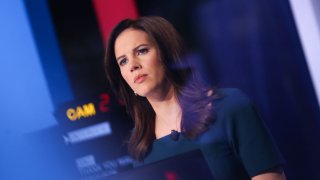
Pretty impressive move in the 10-year Treasury note yesterday; the yield jumped above 0.95% and is holding there this morning. That puts us back to nearly the highs we reached on election night. We haven't been above 1% since March.
It wasn't just there that we saw some big bond-market moves; investors also piled into high-yield a.k.a. "junk" bonds and drove the yield on the Barclays' index down by the same amount as Treasury yields rose, about 10 basis points. That's a pretty big "risk-on" signal, as analyst Brian Reynolds of Reynolds Strategy pointed out; what's more, it's the second such day in a month of such combined moves (the first being Nov. 9th, on Pfizer's vaccine announcement). That means we've got a "cluster" now of risk-on credit days, which is historically a bullish thing.
The last ones were in 2015 and 2016; prior to that, in 2011. Going back to 2009, stocks have risen on average about 10%, Reynolds says, in the six months after such clusters. That would put the S&P over 4000 by late spring, echoing the consensus now of most of Wall Street (and the call we first heard from Larry Lindsey over the summer).
But wait--we already know the market is over-loved here. Bullish sentiment is at extremes; the CNN Fear & Greed index has been in the 90s ("Extreme Greed") over the past week. Reynolds is particularly concerned about the huge spike in equity call options this past month, topping the records we've already seen this year.
So yes, expect some market disruption here in the near-term. Maybe it's another tech shakeout, like we saw in early September; indeed, big-cap tech is still down about 10% from those highs. Maybe it's the broader averages this time. Who knows. But beneath the surface, in the bond and credit markets, the gears are shifting in a way that suggests the macro outlook is becoming more solid.
Aside from the yield moves in Treasuries and junk credit, inflation expectations have also been on the rise. By one gauge, the 30-year TIPS spread, we've been at 52-week highs and just below the "magic" 2% number, as Peter Boockvar and Michael Darda have pointed out. That's the Fed's inflation target in the long run, a target that until lately has seemed almost comically out of reach.
It's a small start that depends a lot on the right stimulus noise coming out of Washington, on top of the economic data holding in there through what's been an awful third wave of Covid. But it tells you that 2021 could turn out to look much more "normal" (the 10-year yield over 1%!) than many have feared.
Money Report
See you at 1 p.m!
Kelly






